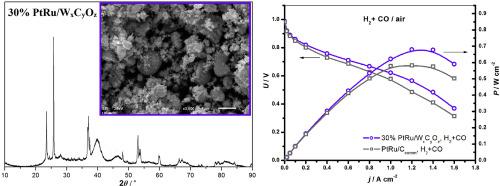International Journal of Hydrogen Energy ( IF 7.2 ) Pub Date : 2020-04-02 , DOI: 10.1016/j.ijhydene.2020.03.086 Snezana M. Brkovic , Milica P. Marceta Kaninski , Petar Z. Lausevic , Aleksandra B. Saponjic , Aleksandra M. Radulovic , Aleksandra A. Rakic , Igor A. Pasti , Vladimir М. Nikolic

|
Durability and cost of Proton Exchange Membrane fuel cells (PEMFCs) are two major factors delaying their commercialization. Cost is associated with the price of the catalysts, while durability is associated with degradation and poisoning of the catalysts, primarily by CO. This motivated us to develop tungsten-carbide-oxide (WxCyOz) as a new non-carbon based catalyst support for Pt–Ru–based anode PEMFC catalyst. The aim was to improve performance and obtain higher CO tolerance compared to commercial catalysts. The performance of obtained PtRu/WxCyOz catalysts was investigated using cyclic voltammetry, linear scan voltammetry and rotating disk electrode voltammetry. Particular attention was given to the analysis of CO poisoning, to better understand how WxCyOz species can contribute to the CO tolerance of PtRu/WxCyOz. Improved oxidation of COads at low potentials (E < 0.5 V vs. RHE) was ascribed to OH provided by the oxide phase at the interfacial region between the support and the PtRu particles. On the other hand, at high potentials (E > 0.5 V vs. RHE) CO removal proceeds dominantly via OH provided from the oxidized metal sites. The obtained catalyst with the best performance (30% PtRu/WxCyOz) was tested as an anode catalyst in PEM fuel cell. When using synthetic reformate as a fuel in PEMFC, there is a significant power drop of 35.3 % for the commercial 30% PtRu/C catalyst, while for the PtRu/WxCyOz anode catalyst this drop is around 16 %.
中文翻译:

用于PEM燃料电池的非化学计量的碳化钨负载的Pt-Ru阳极催化剂-从基本电化学到燃料电池性能
质子交换膜燃料电池(PEMFC)的耐用性和成本是阻碍其商业化的两个主要因素。成本与催化剂的价格有关,而耐用性与催化剂的降解和中毒(主要是由CO引起的)有关。这促使我们开发碳化钨氧化物(W x C y O z)作为一种新型的非碳。 Pt-Ru基阳极PEMFC催化剂的基体催化剂载体。与工业催化剂相比,目的是提高性能并获得更高的CO耐受性。所得PtRu / W x C y O z的性能使用循环伏安法,线性扫描伏安法和旋转盘电极伏安法研究了催化剂。特别关注了CO中毒的分析,以更好地了解W x C y O z物种如何有助于PtRu / W x C y O z的CO耐受性。CO的改进氧化广告在低电势(Ë <0.5伏VS。RHE)归因于OH在支撑件和的PtRu颗粒之间的界面区域中提供由氧化物相。另一方面,在高电势下(E > 0.5 V vs. RHE),CO去除主要进行通过从氧化的金属位点提供的OH。测试获得的性能最佳(30%PtRu / W x C y O z)的催化剂作为PEM燃料电池中的阳极催化剂。当使用合成的重整作为PEMFC的燃料,有35.3%的商业30%的PtRu / C催化剂显著功率下降,而对于的PtRu / W X ç ý ö Ž阳极催化剂这降约为16%。


























 京公网安备 11010802027423号
京公网安备 11010802027423号